Text
WEEK NINE
entry 8
What is “universal design” and what are its historical precedents?
The article addresses universal design as making one object the same across the board, to appeal to the greater masses based on ‘the singular archetype/essence.’ These thoughts on universal design came to be partially from Plato’s beliefs of essentialism. Plato believed that “a singular essence/definition of any form or idea must exist spatially and atemporally to attain universal applicability among its various representations,” Henry. This meaning that because humans are all dissimilar, we must base our universal design on a universal figure, to best appeal to everyone. Plato believed we should base this figure on the “elusive man,” the perfect representation of humanity which we later adopt as the Vitruvius Man, a proportional system design by Roman architect Marcus Vitruvius Pollio, Henry.
What is “essentialism”?
Essentialism (similar to the idea of universal design) is the belief that we all have a strict set of characteristics that make up who we are, those who don't have these characteristics are not considered normal. This continues to shape how we see and deal with diversity, often excluding the ‘other’ in universal design and other aspects of living.
What problems does the author have with universal design?
The other points out that the ideal universal design is based on beliefs from the era of the Roman Empire. This is quite troubling. Many things have changed since then, including our views on those who are different than the average person. To base the universal design on beliefs from over 2000 years ago is crazy! Architects continue to base design on a “uniform, one size fits all environment, and they continue to (perhaps subconsciously or without knowledge) follow Plato’s philosophy. The archetypes that Plato based his theories on “exist outside of this work and outside of time,” there is no perfect man. Henry states that the “reluctance to reject Plato's philosophy has been detrimental to universal design and that this cannot be overstated,” Henry.
Why does the author say there is “a disconnect between how some architects conceptualize universal design and the reality of the world”?
Similar to the question above, Henry states that there is “a disconnect between how some architects conceptualize universal design and the reality of the world,” because the universal design is based on the perfect man and the perfect man does not exist in our world. Like the example stated in the text if were to base all doghouses on the ‘true form’ of the dog (the wolf), dog house would not be comfortable for other breeds such as the smaller pug or the larger great dane. This is how we are designing homes and other buildings.
Do you agree with how the article ended? Why?
I agree with Henry’s beliefs on what universal design has done, and how it has impacted our architecture today, but I thought that the article ended too abruptly. There was too much buildup for such a brief ending.
Provide an example of something in the world around you that could benefit from “mass customization.”
I feel like something that could benefit from “mass customization” are books. All books are the same for the most part -- front and back cover, with pages in between (let's pretend electronic books don't exist for the moment.) Regular books were designed for someone with perfect vision, and both hands to read, how do we change the design of a book for someone who has one arm? No arms? Near-sighted? Far-sighted? Blind? How do we change the book so it can better accommodate all these differences without becoming hard to get?
thank you for reading,
Lamyra Adams
0 notes
Text
WEEK SEVEN
"The Modernist Architecture of Le Corbusier”
Who was Le Corbusier? What were his "five points" of architecture? (see your lecture notes or do some research to find your answers).
Next, please do a brief web search for buildings designed by Le Corbusier. Choose one building. Provide a photograph of the building in your post (identify it). How does Le Corbusier incorporate some or all of his five points of architecture in your chosen building?
Lastly, can you see the legacy of Le Corbusier around you today? Is there a building on campus or one that you know elsewhere that reminds you of his work? What factors of this building remind you of Le Corbusier's architectural principles?
_______________________________________________________________________
Le Corbusier, originally Charles-Edouard Jeanneret, was a Swiss-French architect, painter, and designer. When he was younger he apprenticed with Peter Behrens at AEG and has taken influence from some of Behrens designs in his own work. His work is highly remnant of Purism, which was meant to remake the work in the wake of war, and L’Esprit Nouveau, which was meant to show how mass production and standardization had value. He revolutionized modern interiors by emphasizing their functions.
He followed five steps in most of the architectural renderings. The first being building supports -- these are reinforced concrete columns that support the structure of the building. The second step; rooftop gardens -- these were meant to control humidity and temperature of the concrete building. This also allowed city-dwellers a respite from city life, allowing a healthy coexistence with plant life. The third step was the free designing of the ground plan. Because Le Corbusierused support columns to hold the building, he was able to place interior walls anywhere he wanted. This allowed for more artistic interior design choices and a more interesting internal layout. The third step was designing the windows to span the facade of the building horizontally. This allowed light and air to enter the building in large quantities, again reinforcing that city to the country aesthetic that was so sought after. The fifth step was free designing the face. Again, because the facade is not load-bearing, it is able to accommodate as many windows as the architect desires, as well as allows them to extend outwards, beyond the support column, Postwar Modernist Reconstruction Efforts Lecture Slides.
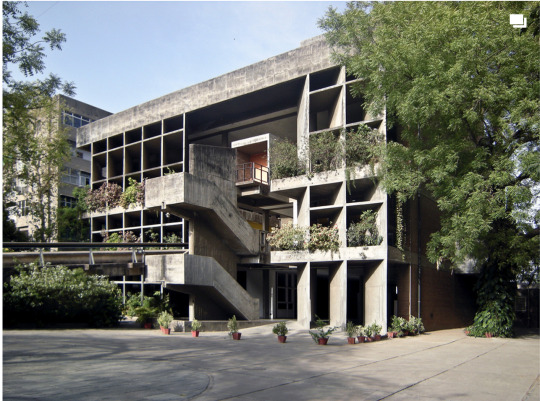
This building of Le Corbusier’s, Mill Owners’ Association Building in Ahmedabad, puts emphasis on step two -- nature and the industrial coexisting, ‘a respite from city life.’ In all the windows, which expand along the facade of the building horizontally, there are planters filled with large vegetative plants. Sprawling and green the plants take up the majority of the balconies/windows creating an almost forest/jungle-like aesthetic, Rennie Jones AD Classics: Mill Owners' Association Building / Le Corbusier.
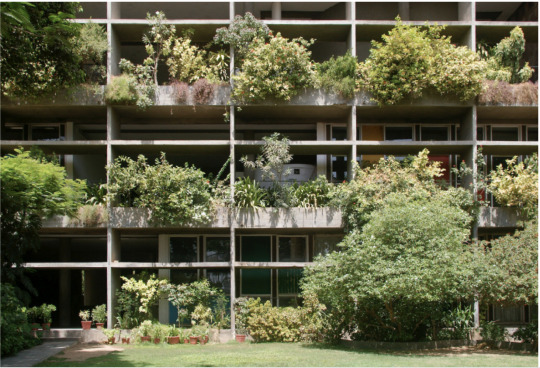
I’d say the most notable of Le Corbusier’s design element found in architecture today, especially on our campus in the Entrepreneurship Center building and the Taller glass building next to it, are the huge windows. The building is almost entirely made of windows, suggesting that there a hidden support structure withing the building that allows for the free design of the facade. Some of the buildings on campus, like the Student Union, have solar panels and plants growing on the roof as well, maybe influence from Le Corbusier’s rooftop garden architectural plans.
Thank you for reading,
Lamyra Adams
0 notes
Text
WEEK SIX JOURNAL
Choose one designer you learned about from each article (two designers in all). What do you like about your designers? Go beyond the article and research your designers. Include an image of their work for you to analyze.
Felicite Landrivon grew up in Lyon, France collection xeroxed posters. This sparked her love of design. In Lyon there is a prominent culture centered around flyposting, placing advertisements without permission amongst large public areas where they might be seen by consumers. Through collecting these posters Landrivon was exposed to Grrrnd Zero (I can't elaborate on Grrrnd Zero that much, because everything I've found is in French. I think it is a mix between a design collaborative and a live music venue.) Landrivon joined the Grrrnd Zero art collective in 2008 and began to design posters and organizing shows even though she had almost no experience -- she based a lot of her work on what she had seen and collected, Ruby Boddington, “Oddities, clumsiness, and dogs.”.
There is a lot going on in most of Landrivon’s works. A collage of vintage photos, interesting type, and strange colors are made to play quite well together. Her work is not something that I initially found appealing, it reminded me of those posters that get stuck up hastily in the entrance of a building. As I continued to analyze her work I found that there was a strange elegance in the way these seemingly out of place graphics stand apart. Her work Landrivon tends to reference the 60s and 70;s counterculture press, punk minimalism, psychedelic zines, anonymouse design, amateurism vernacular fonts, oddities, clumsiness, and dogs,” Ruby Boddington, “Oddities, clumsiness, and dogs.”
This specific piece was one of my favorites. The colors and type specifically are my favorite parts. I appreciate how the time leads yours around the page. I was initially drawn to the text ‘schlaasss’ then brought down the page as the pictures angled into ‘pcp manor’ and ‘surprises’. I then rea upwards from the elephant, speech bubble, ‘sheer mag’ and finally ended on the top bits of info (I’m assuming the date, issue, and price).
https://www.itsnicethat.com/articles/felicite-landrivon-graphic-design-140218
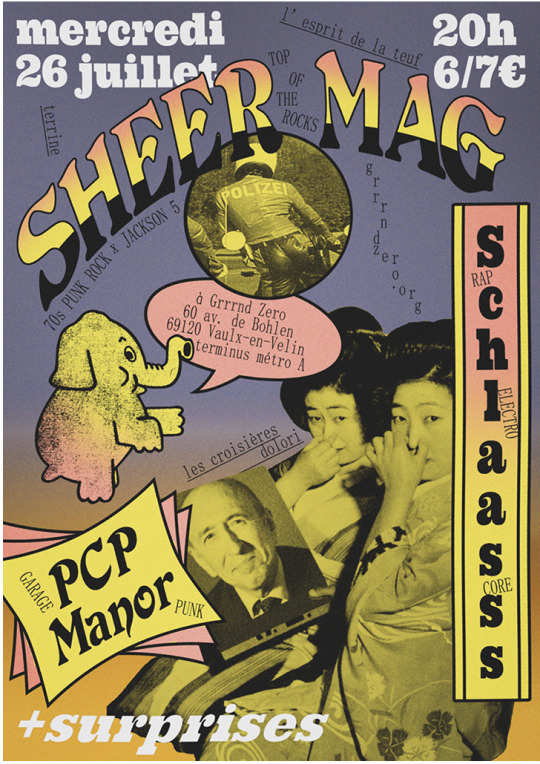
Emory Douglas grew up in the San Francisco bay area, and as a teenager was incarcerated at the Youth Training School in Ontario, California. He worked in the prison printing shop and when he went on to attend San Francisco City College, he studied commercial art and became apart of the Black Students Union actively participated in political activism. This later lead him to be the Revolutionary Artist and Minister of Culture for the Black Panther Party, where he oversaw art direction and production of the party's official newspaper. Douglas was inspired by the civil rights movement as artists such as Charles White, Aaron Douglas, and Elizabeth Catlett. He used this inspiration to create moving works for The Black Panther and urged the party to focus on reaching less literate, poorer communities, and to use cheaper means of commercial art production, Pitchaya Sudbanthad “Emory Douglas.” I like Emory Douglas’s work a lot. There is so much depth, history, and emotion within each piece that the conceptual aspect of his posters speak louder than the actual design itself. To offset this, I think Emory packs his posters with strong blacks and reds, as well as rigid graphics that are sharp across the entire poster. This piece exudes power -- children, our future, radiate knowledge, love, and learning. The red sunburst alludes to an enlightenment oof younger generations and a prosperous, and education future for people of all races.
https://www.aiga.org/design-journeys-emory-douglas
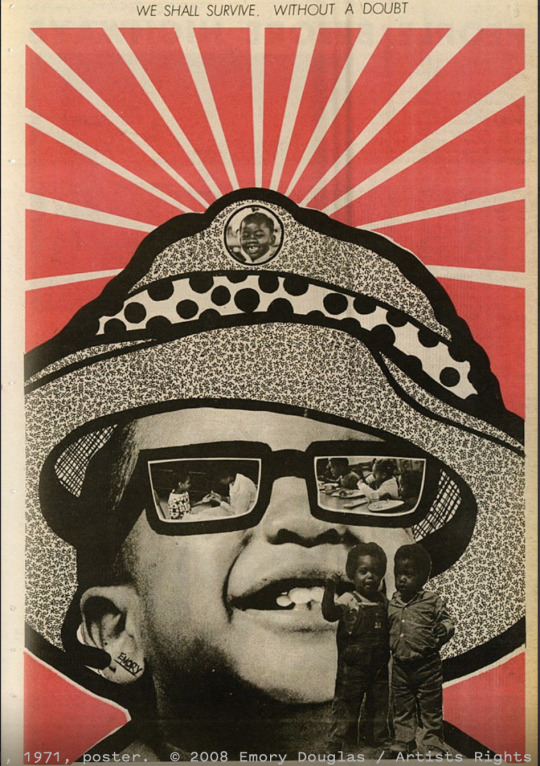
Lamyra Adams
0 notes
Text
Week 5 Journal Entry
"Design History and Your World"
Pull at least two examples of design from Chapters 2 (pages 95-102) and 3 (all) from your textbook or from this week's lectures. Write a paragraph that compares your chosen works with at least two examples of design you see around you on a daily basis. Take photographs of these with your phone. In your journal post, provide images of all works (both the famous works and objects from your daily life). Label each image. Your analysis should include some in-text citations from the textbook to prove you have engaged with Chapters 2 (pages 95-102) and 3 (all).
From chapters 2 and 3 I choose Peter Behrens, Darmstadt, 1901 poster, and Tristan Tzara’s Bulletin Dada, no.6. 1920, periodical -- two graphic poster styled works. I am comparing these with my Make Art Not War sticker by Obey and my Collectivo collectible poster (free from Collectivo).
Peter Behrens, a German architect, was a well-known member of the Darmstadt art colony established in 1899, which sought to “promote high standards for crafts made in the region,” Eskilson 102. Being one of the more accomplished designers at the colony, Behrens career focused on the fine and applied arts, and he was invaluable in the spread of new, non-academics styles in the fine arts. His 1901 Darmstadt Poster is as if Early Art deco had a baby with Art Novvouue. Typical of Scottish and Viennese work, Behrens poster is in a vertical format, with a much more subdued stylization of the female figure, and a relatively plain text. There are not many frills decorating the poster aside from the symmetrical crowns and the vertical lines emulating the rectangular format of the entire poster surrounding either side of the female figure, and the text is very plain, condensed, capital letters that reverses the color scheme of the image, Eskilson 102. Like art nouveau, I catch very Alphonse-Mucha-esque vibes front these pieces as well. The thin graceful vertical position of the poster is very an art nouveau portrait style that Behrens utilizes, as well as the lithe, elegantly clothed female figurine in the center of the poster. The female figure in the middle is reminiscent of a goddess holding and standing upon to glowing white orbs, and on either side of her raised hands are the aforementioned crowns, the duke’s coat of arms, representing the notion that the Darmstadt Art Colony is one of the elite artists with a higher understanding of art and the ability to create art in a unified style.
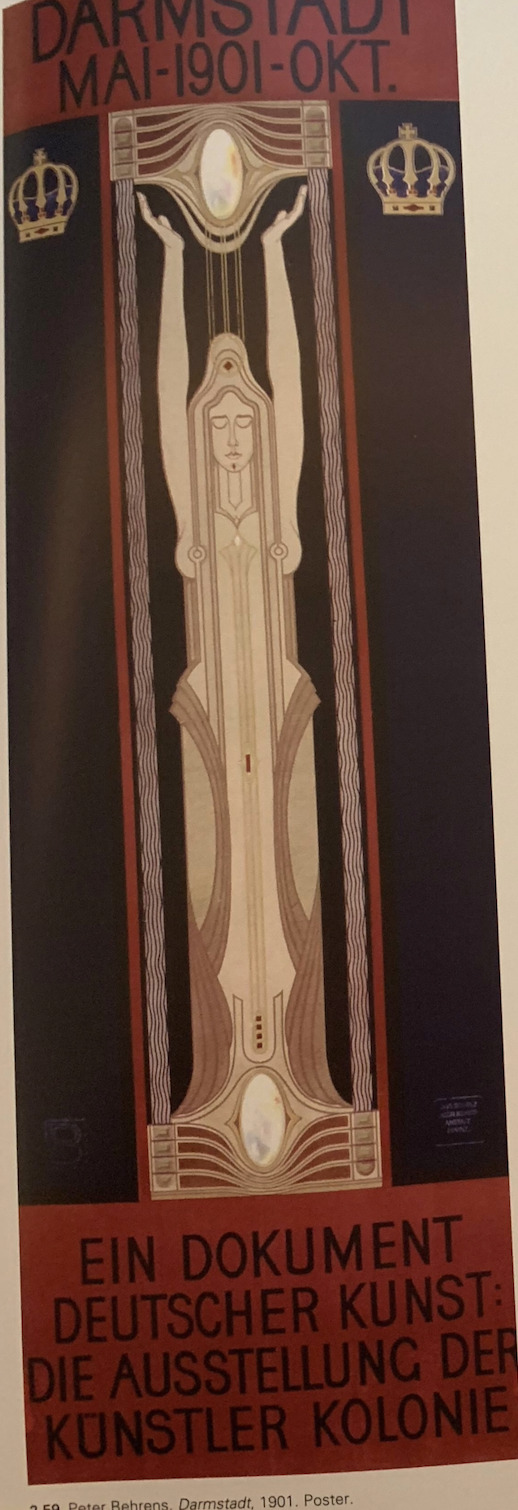

I compare this piece to the Make Art, Not War (MANW) poster by Shepard Fairey. I see this poster in the form of a sticker on my laptop every time I use it. The MANW poster is a very symmetrical piece of art with the same color scheme as THe Darmstadt poster -- red, white, and black. They are also both fairly symmetrical and have a female figure represented in the middle of the work, although on my MANW sticker (which is normally a poster, or sweatshirt decal) is only the head of the woman. They also both have very plan, sans serif fonts even though the font on the MANW is curved to fit around the head of the female centerpiece. I think I would consider both works to be extremely similar, and kind of meant to spark inspiration and aspiration in those who look at them -- join Darmstadt, save the human race from itself, the same thing.

(I could not find a picture of the Colectivo poster! I'm currently at. home and will not be able to get a picture from my dorm room until Sunday -- I will email the photo.)
20 years later…
I'm looking at the Bulletin Dada Periodical by Tristan Tzara. Tzara gained influence from the journal he founded, Dada, and a “new generation” of French writers who some went on to begin the surrealist movement after Dada. Issue no. 6, Bulletin Dada, of his journal, Dada, features a wide range of eclectic typeface, in an array of different ways and forms. Red and black letters stand out against the white of the paper, although ith can be hard to read some text because it has been overlaid on top of other text. Tzara purposefully overpriced blocks of text and used random typefaces to boost a sense of delicate improvisation. Even though the Bulletin Dada is quite a baffling and crazy piece of art for its times, there is enough clarity in the pieces to introduce a new slew of Dadaists, “a whole new roster of Dadaists who were scheduling several new public performances.” Eskilon 133.
I compare this piece to one of the collectible Colectivo posters that I got for free. I’d go as far as to say that the two pieces of art are almost opposites. The Colectivo post at a soft mustard yellow is a tangle of black and white text and a black and white skull, somewhat blending until its hard to make out what it says. The collectible poster was made for a completely different purpose than the Dada Bulletin. It is a piece of art meant to be pretty and admired by customers who frequent Colectivo, the Bulletin Dada was meant to introduce new dadaists and serve as a form of satirical work, that plays with the boundaries of art.
Thank you, Lamyra Adams
0 notes
Text
Week 3 Journal Entry
How would you define design? Can you give me a few examples of design thinking in products you use? Expand on what you found to be the most significant concept from this week's reading.
Describe IDEO’s process of innovation. What are some of the company's mottos and rules and how are these implemented? Finally, can you think of any creative ways IDEO might have improved their final shopping cart design?
Hi,
After reading “Design Thinking” in the Harvard Business Review, I would define design as a multistep, complicated, teamwork process that involves multiple bouts of trial and error, as well as 100 percent open-mindedness, empathy, optimism. After reading the article aesthetics seem to be the last thought in my mind when I think of design. I realize now there are so many more core concepts to design and design thinking than what I previously believed.
Design thinking is in the everyday products we use. For instance, a toothbrush and toothpaste were invented for cleaning teeth and gums by an inventor/scientist whereas the shape, density, size, and mechanics behind the product are created by a designer to make the object functional, and improve the experience for the user. Some toothbrushes are designed with soft round grips for comfort, or rubber bristles for polishing, and even scrapers for gums and your tongue. Some tubes of toothpaste are squeezable, some are solid, and they have all different sorts of caps for different purposes. You don't have to be a dentist to improve the toothbrush -- not all of these design elements are necessary for tooth care specifically, but rather for the overall experience of brushing one's teeth.
The article by Tim Brown writes a side bar about The Design Thinkers Profile, that list for five necessary steps; “empathy, integrative thinking, optimism, experimentation, and collaboration,” I’d say these are all steps you could include in the definition of design, because without them I don't think a design can be successful.
IDEO has many mottos and ‘rules’ they like to follow that help improve their design and innovation process. I will list them here,
“Look around the only thing not designed by anybody is nature.”
“Don’t listen to the boss.”
“One conversation at a time.”
“Stay focused on the topic.”
“Encourage wild ideas.”
“Defer Judgment.”
“Build on others' ideas.”
“Enlightened trial and error succeeds over the planning of the lone genius.”
“Allow focused/constructive chaos.”
“Be playful.”
“Fail often in order to succeed sooner.”
IDEO follows The Design Thinkers Profile almost to a T -- especially by using their mottos as a guideline to their process. They discuss the problem, in this case, the average shopping cart. They talk about what issues they have had with it. They split up and survey/ask real people what problems they've had -- moms, store managers, misc. shoppers, hospitals, etc. They reconvene and lay out all the issues they’ve been able to find. After this, they make as many ideas as possible with possible ideas to fix the issues addressed (no idea is a stupid idea at IDEO -- there must be creative and outlandish ideas to reach innovative ways of thinking). They then split up, and address one broad issue as a team and create multiple prototypes. They reconvene, critique, and combine their prototypes into the ultimate prototype, addressing as many issues as they can while staying in believable realms of technology and mechanics.
I'm not sure what I would have added the carts, to be honest, I think they had a pretty amazing idea already. Perhaps they could have added a hook or basket under the handlebar in order to store one’s belongings/purse?
Lamyra Adams
0 notes
Text
WEEK TWO
Arts & Crafts & William Morris
For your journal entry, please choose two works of design by Morris that you feel respond to the conditions of modernity as outlined in your textbook. What was the Arts and Crafts Movement and what were Morris's goals with his designs? Do you agree or disagree with Morris's opinions? Please properly cite any quoted material and provide good evidence that you read all assigned readings.
Hi,
We started our readings exploring design and machine-related innovations of the Industrial Revolution and how they impacted society. This new ‘tech’ such as the steam engine (allowing for steam-operated presses to evolve) allowed mass production of printed materials, such as newspapers, advertisements, and books, in turn enabling “mass literacy and communication of an altogether new scale,” Eskilson 28.
There were also negative impacts on our society, such as “brutal living conditions, and working conditions for the urban poor,” and the fall of “the independent creativity of the workman,” Eskilson 29, 50.
William Morris believed that the Industrial Revolution allowed mass-produced goods to flood the markets and that these goods were “ugly” and “often lacked artistic merit,” Eskilson 50. In the text, we are told that because of his disdain for the aesthetics of the late 19th century, “Morris dedicated his life to improving the quality of British design.” In order to do so, he opened his own design firms, such as Morris and Co., with the intent of selling goods that served their “utilitarian purpose” but at the same were beautiful and a mark of craftsmanship.
By encouraging handmade items/design arts Morris believed that he could improve the lives of everyday working people, and in the early 1890s his “type of subdued, harmonious design” was coined the Arts and Crafts style, and this “idealization” of small scale production of handcrafted items was therefore called the Arts and Crafts Movement, Eskilson 51.
I think Morris had the right idea but executed it 100% wrong. Yes, I believe that we should celebrate artists and their handcrafted works, and it’s sad that kitschy bobbles are around every corner, but we cant reform design if the handcrafted works/designs become inaccessible to the average citizen.
For instance, we have Morris’s Minstrel with Clarient. You would not find a beautiful, handcrafted piece of stained glass in a low income home in the late 1800s. This was something either the designer, the elite, or the church owned.
We have the same situation with Morris’s Sussex Chair, beautiful, often made with mahogany and precious woods -- clearly impractical for those who were not wealthy.
Bottom line, It was more realistic for the average public to by‘mass produced’ products than to sell themselves out of house and home for a handcrafted dining table and chair set -- but hey, at least it’s pretty?
Thanks for reading,
Lamyra Adams
0 notes
Text
WEEK ONE
About Me
Tell us all a little about yourself. Why did you take this class and what is your interest in design? Do you have any relevant experience? What inspires you? Have you recently purchased any items where design was a deciding factor over a competitor?
Hi,
My name is Lamyra (la-meer-ah) Adams, but I mostly go by Myra (meer-ah). Im from Sturgeon Bay, which is located on the Door County Peninsula -- the thumb of Wisconsin. Im a sophomore on the DVC track, so Design Survey happens to be a requirement. Im excited to see what I’ll learn in this class, in regards to ‘design theory and methodologies’ as it says in the syllabus. I’ve never really thought about origins/history of design so I think class will be a real eye opener.
Design plays a huge factor in not only the work I make but the work we all make. I’ve definitely used the elements and principles of design in almost all of my works, whether it was a well thought out decision or a subconscious one. Even within this first week of class im learning/realising how much design plays into our artistic decisions. I think the aesthetics of design also play a role in what art we find personality attractive -- we tend to drift towards in the art museum or on an internet app such as Pinterest.
A lot of my art is inspired by nature and people. I know that sounds very basic. I try to combine them as much as possible. I like to collect open source photos on the internet (especially vintage) and then I rework them into my own art as collage elements. I especially enjoy creating my own Photoshop Brushes and creating radial designs, or patterns with the cut out photos.
I’d say design is a huge factor in my ‘shopping life’ when it comes to clothes. I follow a lot of designers on Instagram and If I wanted to I could go bankrupt on buying clothes purely to hang them in my closet and just look at them. Clothes are so pretty. I know this sounds shallow, but I find it interesting how someone can express a certain personality, aesthetic, or period in time.
I could go on but I think this should enough info,
Thanks for reading!
Lamyra Adams
1 note
·
View note